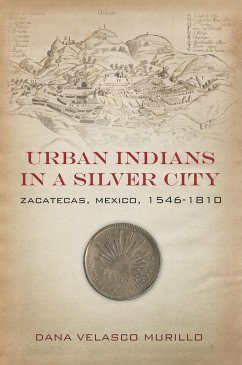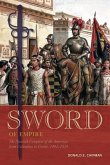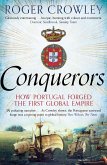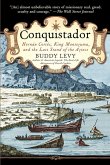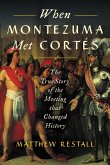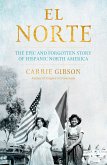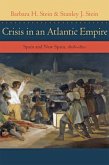- Gebundenes Buch
- Merkliste
- Auf die Merkliste
- Bewerten Bewerten
- Teilen
- Produkt teilen
- Produkterinnerung
- Produkterinnerung
Dana Velasco Murillo is Associate Professor of History at the University of California, San Diego.
Andere Kunden interessierten sich auch für
![Sword of Empire Sword of Empire]() Donald E. ChipmanSword of Empire34,99 €
Donald E. ChipmanSword of Empire34,99 €![Conquerors Conquerors]() Roger CrowleyConquerors11,99 €
Roger CrowleyConquerors11,99 €![Conquistador Conquistador]() Buddy LevyConquistador18,99 €
Buddy LevyConquistador18,99 €![When Montezuma Met Cortés When Montezuma Met Cortés]() Matthew RestallWhen Montezuma Met Cortés20,99 €
Matthew RestallWhen Montezuma Met Cortés20,99 €![The Italian Wars Volume 5 The Italian Wars Volume 5]() Massimo PredonzaniThe Italian Wars Volume 543,99 €
Massimo PredonzaniThe Italian Wars Volume 543,99 €![El Norte El Norte]() Carrie GibsonEl Norte29,99 €
Carrie GibsonEl Norte29,99 €![Crisis in an Atlantic Empire Crisis in an Atlantic Empire]() Barbara H. SteinCrisis in an Atlantic Empire109,99 €
Barbara H. SteinCrisis in an Atlantic Empire109,99 €-
-
-
Dana Velasco Murillo is Associate Professor of History at the University of California, San Diego.
Hinweis: Dieser Artikel kann nur an eine deutsche Lieferadresse ausgeliefert werden.
Hinweis: Dieser Artikel kann nur an eine deutsche Lieferadresse ausgeliefert werden.
Produktdetails
- Produktdetails
- Verlag: Stanford University Press
- Seitenzahl: 328
- Erscheinungstermin: 22. Juni 2016
- Englisch
- Abmessung: 231mm x 155mm x 20mm
- Gewicht: 618g
- ISBN-13: 9780804796118
- ISBN-10: 0804796114
- Artikelnr.: 44382748
- Herstellerkennzeichnung
- Libri GmbH
- Europaallee 1
- 36244 Bad Hersfeld
- 06621 890
- Verlag: Stanford University Press
- Seitenzahl: 328
- Erscheinungstermin: 22. Juni 2016
- Englisch
- Abmessung: 231mm x 155mm x 20mm
- Gewicht: 618g
- ISBN-13: 9780804796118
- ISBN-10: 0804796114
- Artikelnr.: 44382748
- Herstellerkennzeichnung
- Libri GmbH
- Europaallee 1
- 36244 Bad Hersfeld
- 06621 890
Dana Velasco Murillo is Associate Professor of History at the University of California, San Diego.
Contents and Abstracts
Introduction: Silver Veins, Urban Grids, and Layered Identities
chapter abstract
The introduction argues that in spite of the importance of Native American
emigrants, the mining historiography for Spanish America has concentrated
on either the roles and activities of Spaniards or the impact of silver
production on global markets. Studies on native peoples and silver mining
are few in number, and primarily focused on men, their roles as temporary
or coerced workers, and the hardships and exploitative conditions of mine
labor. Urban Indians shifts the focus from indigenous peoples as laborers
to settlers and municipal residents, stressing in the process the important
roles of women and children to mining societies. While previous studies
have stressed dramatic cultural transformation and rapid miscegenation
among urban native peoples, Urban Indians argues that native peoples
exploited the urban milieu to create multiple statuses and identities that
allowed them to develop indigenous identities, practices, and associations,
even as they embraced Spanish-style civic life.
1A Tale of Two Settlements, 1546-1559
chapter abstract
Chapter 1 considers the role of Zacatecas's preconquest indigenous
population on the city's early development, the impact of Spanish
dependence on foreign Indian population to meet labor needs, and the
evolution of Spanish and indigenous settlements from rudimentary mining
camps to urban communities in the sixteenth century. It argues that the
mines could not have prospered without the large migrant Indian population
from central and western Mexico that displaced the local Zacateco
population. They provided the necessary labor for the emerging mining
economy and its subsidiary activities, and by creating indigenous
communities, they brought into being a permanent and long-term labor
source. As the indigenous workforce established roots in the town, they
began adapting the Spanish urban environment to meet their own settlement
needs, exploiting Zacatecas's frontier setting and labor shortages to
derive some concessions, such as mobility, wages, freedom from tribute and
rotary labor drafts, and semiautonomous neighborhoods.
2Ethnic Cohesion and Community Formation, 1560-1608
chapter abstract
This chapter explores the factors and conditions that facilitated ethnic
cohesion among the ethnically diverse native population and the development
of indigenous civic life from the mid- to late sixteenth century.
Indigenous migrants adopted and negotiated colonial spaces and institutions
to re-create central Mexican-style indigenous communities and establish a
corporate Indian status, allowing them to draw on concessions and
protective measures afforded to native peoples under colonial rule. The
evolution of a "Republic de Indios," barrios of native communities on the
outskirts of the city, created spaces where native peoples could practice
indigenous and Spanish lifeways. Shared housing and labor arrangements
unified the native population through personal and professional ties. The
establishment of indigenous confraternities allowed native peoples to
develop formal social and political organizations. Even as native peoples
began assuming the role of urban vecinos, or municipal residents, they
continued to identify with their ancestral heritage.
3The Creation of Indian Towns and Officials, 1609-1650
chapter abstract
This chapter examines the creation of formal indigenous towns, municipal
councils, and leaders in the seventeenth century. It argues that the
impetus for creating Indian towns and municipal councils came from an
indigenous population lacking vehicles for redress and governance. It
outlines the establishment of four Indian towns, Tlacuitlapan, Tonalá
Chepinque, San Josef, and El Niño. It charts the evolution of Indian
governance from the initial appointment of native alcaldes to the
development of full-fledged indigenous municipal councils modeled on
Spanish and preconquest indigenous governance practices. It discusses the
changing nature and role of native rulers, highlights trends in the ethnic
composition of the leadership, and documents the rise of a group of
professional officeholders. Indigenous towns and municipal councils in
Zacatecas provided native peoples with a modicum of juridical autonomy over
indigenous affairs as it provided them entry into greater civic life within
and outside of indigenous spaces.
4Indios and Vecinos: The Maturation of Urban Indigenous Society, 1655-1739
chapter abstract
This chapter examines the maturation of urban indigenous society in
Zacatecas, both at the community and individual level, in the midcolonial
period. During this period, revitalized silver production and markets, and
growing populations of non-Indians, drew native peoples further into the
money-economy and into greater interactions with ethnically diverse
producers and consumers. Yet indigenous societies survived and flourished
within these social and demographic changes because of the stability of
native institutions and communities, and native vecinos who retained their
associations with the indigenous world even as they acquired the skills and
fluency to succeed in the Spanish urban environment. Permanent residents
and incoming immigrants created a critical population mass that facilitated
continued indigenous social and kinship networks. By the early eighteenth
century, native peoples had developed the practices and institutions they
needed to survive and prosper as a community and ethnic group in the city.
5Revival and Survival: Indigenous Society in the Mid-to-Late Colonial
Period, 1730-1806
chapter abstract
Chapter 5 explores the dramatic changes at the local and viceregal level
that indigenous peoples confronted during the long eighteenth century.
Production declines and upsurges, empirewide administrative projects to
centralize authority and increase economic productivity, often referred to
as the Bourbon Reforms, and a rise in casta, or non-Indian, populations,
affected native lands and resources, religious organizations, labor
practices, and systems of governance. This chapter argues that indigenous
societies and institutions remained fairly vital through the mid-1770s and
that native peoples played a key role in the city's economic, social, and
demographic recovery. But social, economic, and demographic changes during
the last decades of colonial rule (1775-1810), particularly Spanish
attempts to dissolve Indian towns and municipal councils, weakened and
undermined indigenous communities and institutions to the point that they
eventually ceased to function as autonomous units in the postindependence
period.
Conclusion: From Indigenous Towns to Mestizo Barrios
chapter abstract
The conclusion offers some thoughts on the fate of the city's native
communities and population after Mexico gained independence from Spain and
the nature of mestizaje in northern New Spain. In Zacatecas, the
dissolution of the native pueblos in 1832, and Mexican laws prohibiting
classifications of native people as Indians, undermined indigenous
leadership, organizations, and corporate structures. The decline of
indigenous institutions and societies accelerated Zacatecas's demographic
and cultural mestizaje. Yet the chapter's argument that the mestizaje of
the city occurred much later than is usually presented in the
scholarship-beginning in earnest only in the late eighteenth
century-provides a more nuanced picture of the complex cultural changes and
transformations that shaped Mexico's mestizo north.
Introduction: Silver Veins, Urban Grids, and Layered Identities
chapter abstract
The introduction argues that in spite of the importance of Native American
emigrants, the mining historiography for Spanish America has concentrated
on either the roles and activities of Spaniards or the impact of silver
production on global markets. Studies on native peoples and silver mining
are few in number, and primarily focused on men, their roles as temporary
or coerced workers, and the hardships and exploitative conditions of mine
labor. Urban Indians shifts the focus from indigenous peoples as laborers
to settlers and municipal residents, stressing in the process the important
roles of women and children to mining societies. While previous studies
have stressed dramatic cultural transformation and rapid miscegenation
among urban native peoples, Urban Indians argues that native peoples
exploited the urban milieu to create multiple statuses and identities that
allowed them to develop indigenous identities, practices, and associations,
even as they embraced Spanish-style civic life.
1A Tale of Two Settlements, 1546-1559
chapter abstract
Chapter 1 considers the role of Zacatecas's preconquest indigenous
population on the city's early development, the impact of Spanish
dependence on foreign Indian population to meet labor needs, and the
evolution of Spanish and indigenous settlements from rudimentary mining
camps to urban communities in the sixteenth century. It argues that the
mines could not have prospered without the large migrant Indian population
from central and western Mexico that displaced the local Zacateco
population. They provided the necessary labor for the emerging mining
economy and its subsidiary activities, and by creating indigenous
communities, they brought into being a permanent and long-term labor
source. As the indigenous workforce established roots in the town, they
began adapting the Spanish urban environment to meet their own settlement
needs, exploiting Zacatecas's frontier setting and labor shortages to
derive some concessions, such as mobility, wages, freedom from tribute and
rotary labor drafts, and semiautonomous neighborhoods.
2Ethnic Cohesion and Community Formation, 1560-1608
chapter abstract
This chapter explores the factors and conditions that facilitated ethnic
cohesion among the ethnically diverse native population and the development
of indigenous civic life from the mid- to late sixteenth century.
Indigenous migrants adopted and negotiated colonial spaces and institutions
to re-create central Mexican-style indigenous communities and establish a
corporate Indian status, allowing them to draw on concessions and
protective measures afforded to native peoples under colonial rule. The
evolution of a "Republic de Indios," barrios of native communities on the
outskirts of the city, created spaces where native peoples could practice
indigenous and Spanish lifeways. Shared housing and labor arrangements
unified the native population through personal and professional ties. The
establishment of indigenous confraternities allowed native peoples to
develop formal social and political organizations. Even as native peoples
began assuming the role of urban vecinos, or municipal residents, they
continued to identify with their ancestral heritage.
3The Creation of Indian Towns and Officials, 1609-1650
chapter abstract
This chapter examines the creation of formal indigenous towns, municipal
councils, and leaders in the seventeenth century. It argues that the
impetus for creating Indian towns and municipal councils came from an
indigenous population lacking vehicles for redress and governance. It
outlines the establishment of four Indian towns, Tlacuitlapan, Tonalá
Chepinque, San Josef, and El Niño. It charts the evolution of Indian
governance from the initial appointment of native alcaldes to the
development of full-fledged indigenous municipal councils modeled on
Spanish and preconquest indigenous governance practices. It discusses the
changing nature and role of native rulers, highlights trends in the ethnic
composition of the leadership, and documents the rise of a group of
professional officeholders. Indigenous towns and municipal councils in
Zacatecas provided native peoples with a modicum of juridical autonomy over
indigenous affairs as it provided them entry into greater civic life within
and outside of indigenous spaces.
4Indios and Vecinos: The Maturation of Urban Indigenous Society, 1655-1739
chapter abstract
This chapter examines the maturation of urban indigenous society in
Zacatecas, both at the community and individual level, in the midcolonial
period. During this period, revitalized silver production and markets, and
growing populations of non-Indians, drew native peoples further into the
money-economy and into greater interactions with ethnically diverse
producers and consumers. Yet indigenous societies survived and flourished
within these social and demographic changes because of the stability of
native institutions and communities, and native vecinos who retained their
associations with the indigenous world even as they acquired the skills and
fluency to succeed in the Spanish urban environment. Permanent residents
and incoming immigrants created a critical population mass that facilitated
continued indigenous social and kinship networks. By the early eighteenth
century, native peoples had developed the practices and institutions they
needed to survive and prosper as a community and ethnic group in the city.
5Revival and Survival: Indigenous Society in the Mid-to-Late Colonial
Period, 1730-1806
chapter abstract
Chapter 5 explores the dramatic changes at the local and viceregal level
that indigenous peoples confronted during the long eighteenth century.
Production declines and upsurges, empirewide administrative projects to
centralize authority and increase economic productivity, often referred to
as the Bourbon Reforms, and a rise in casta, or non-Indian, populations,
affected native lands and resources, religious organizations, labor
practices, and systems of governance. This chapter argues that indigenous
societies and institutions remained fairly vital through the mid-1770s and
that native peoples played a key role in the city's economic, social, and
demographic recovery. But social, economic, and demographic changes during
the last decades of colonial rule (1775-1810), particularly Spanish
attempts to dissolve Indian towns and municipal councils, weakened and
undermined indigenous communities and institutions to the point that they
eventually ceased to function as autonomous units in the postindependence
period.
Conclusion: From Indigenous Towns to Mestizo Barrios
chapter abstract
The conclusion offers some thoughts on the fate of the city's native
communities and population after Mexico gained independence from Spain and
the nature of mestizaje in northern New Spain. In Zacatecas, the
dissolution of the native pueblos in 1832, and Mexican laws prohibiting
classifications of native people as Indians, undermined indigenous
leadership, organizations, and corporate structures. The decline of
indigenous institutions and societies accelerated Zacatecas's demographic
and cultural mestizaje. Yet the chapter's argument that the mestizaje of
the city occurred much later than is usually presented in the
scholarship-beginning in earnest only in the late eighteenth
century-provides a more nuanced picture of the complex cultural changes and
transformations that shaped Mexico's mestizo north.
Contents and Abstracts
Introduction: Silver Veins, Urban Grids, and Layered Identities
chapter abstract
The introduction argues that in spite of the importance of Native American
emigrants, the mining historiography for Spanish America has concentrated
on either the roles and activities of Spaniards or the impact of silver
production on global markets. Studies on native peoples and silver mining
are few in number, and primarily focused on men, their roles as temporary
or coerced workers, and the hardships and exploitative conditions of mine
labor. Urban Indians shifts the focus from indigenous peoples as laborers
to settlers and municipal residents, stressing in the process the important
roles of women and children to mining societies. While previous studies
have stressed dramatic cultural transformation and rapid miscegenation
among urban native peoples, Urban Indians argues that native peoples
exploited the urban milieu to create multiple statuses and identities that
allowed them to develop indigenous identities, practices, and associations,
even as they embraced Spanish-style civic life.
1A Tale of Two Settlements, 1546-1559
chapter abstract
Chapter 1 considers the role of Zacatecas's preconquest indigenous
population on the city's early development, the impact of Spanish
dependence on foreign Indian population to meet labor needs, and the
evolution of Spanish and indigenous settlements from rudimentary mining
camps to urban communities in the sixteenth century. It argues that the
mines could not have prospered without the large migrant Indian population
from central and western Mexico that displaced the local Zacateco
population. They provided the necessary labor for the emerging mining
economy and its subsidiary activities, and by creating indigenous
communities, they brought into being a permanent and long-term labor
source. As the indigenous workforce established roots in the town, they
began adapting the Spanish urban environment to meet their own settlement
needs, exploiting Zacatecas's frontier setting and labor shortages to
derive some concessions, such as mobility, wages, freedom from tribute and
rotary labor drafts, and semiautonomous neighborhoods.
2Ethnic Cohesion and Community Formation, 1560-1608
chapter abstract
This chapter explores the factors and conditions that facilitated ethnic
cohesion among the ethnically diverse native population and the development
of indigenous civic life from the mid- to late sixteenth century.
Indigenous migrants adopted and negotiated colonial spaces and institutions
to re-create central Mexican-style indigenous communities and establish a
corporate Indian status, allowing them to draw on concessions and
protective measures afforded to native peoples under colonial rule. The
evolution of a "Republic de Indios," barrios of native communities on the
outskirts of the city, created spaces where native peoples could practice
indigenous and Spanish lifeways. Shared housing and labor arrangements
unified the native population through personal and professional ties. The
establishment of indigenous confraternities allowed native peoples to
develop formal social and political organizations. Even as native peoples
began assuming the role of urban vecinos, or municipal residents, they
continued to identify with their ancestral heritage.
3The Creation of Indian Towns and Officials, 1609-1650
chapter abstract
This chapter examines the creation of formal indigenous towns, municipal
councils, and leaders in the seventeenth century. It argues that the
impetus for creating Indian towns and municipal councils came from an
indigenous population lacking vehicles for redress and governance. It
outlines the establishment of four Indian towns, Tlacuitlapan, Tonalá
Chepinque, San Josef, and El Niño. It charts the evolution of Indian
governance from the initial appointment of native alcaldes to the
development of full-fledged indigenous municipal councils modeled on
Spanish and preconquest indigenous governance practices. It discusses the
changing nature and role of native rulers, highlights trends in the ethnic
composition of the leadership, and documents the rise of a group of
professional officeholders. Indigenous towns and municipal councils in
Zacatecas provided native peoples with a modicum of juridical autonomy over
indigenous affairs as it provided them entry into greater civic life within
and outside of indigenous spaces.
4Indios and Vecinos: The Maturation of Urban Indigenous Society, 1655-1739
chapter abstract
This chapter examines the maturation of urban indigenous society in
Zacatecas, both at the community and individual level, in the midcolonial
period. During this period, revitalized silver production and markets, and
growing populations of non-Indians, drew native peoples further into the
money-economy and into greater interactions with ethnically diverse
producers and consumers. Yet indigenous societies survived and flourished
within these social and demographic changes because of the stability of
native institutions and communities, and native vecinos who retained their
associations with the indigenous world even as they acquired the skills and
fluency to succeed in the Spanish urban environment. Permanent residents
and incoming immigrants created a critical population mass that facilitated
continued indigenous social and kinship networks. By the early eighteenth
century, native peoples had developed the practices and institutions they
needed to survive and prosper as a community and ethnic group in the city.
5Revival and Survival: Indigenous Society in the Mid-to-Late Colonial
Period, 1730-1806
chapter abstract
Chapter 5 explores the dramatic changes at the local and viceregal level
that indigenous peoples confronted during the long eighteenth century.
Production declines and upsurges, empirewide administrative projects to
centralize authority and increase economic productivity, often referred to
as the Bourbon Reforms, and a rise in casta, or non-Indian, populations,
affected native lands and resources, religious organizations, labor
practices, and systems of governance. This chapter argues that indigenous
societies and institutions remained fairly vital through the mid-1770s and
that native peoples played a key role in the city's economic, social, and
demographic recovery. But social, economic, and demographic changes during
the last decades of colonial rule (1775-1810), particularly Spanish
attempts to dissolve Indian towns and municipal councils, weakened and
undermined indigenous communities and institutions to the point that they
eventually ceased to function as autonomous units in the postindependence
period.
Conclusion: From Indigenous Towns to Mestizo Barrios
chapter abstract
The conclusion offers some thoughts on the fate of the city's native
communities and population after Mexico gained independence from Spain and
the nature of mestizaje in northern New Spain. In Zacatecas, the
dissolution of the native pueblos in 1832, and Mexican laws prohibiting
classifications of native people as Indians, undermined indigenous
leadership, organizations, and corporate structures. The decline of
indigenous institutions and societies accelerated Zacatecas's demographic
and cultural mestizaje. Yet the chapter's argument that the mestizaje of
the city occurred much later than is usually presented in the
scholarship-beginning in earnest only in the late eighteenth
century-provides a more nuanced picture of the complex cultural changes and
transformations that shaped Mexico's mestizo north.
Introduction: Silver Veins, Urban Grids, and Layered Identities
chapter abstract
The introduction argues that in spite of the importance of Native American
emigrants, the mining historiography for Spanish America has concentrated
on either the roles and activities of Spaniards or the impact of silver
production on global markets. Studies on native peoples and silver mining
are few in number, and primarily focused on men, their roles as temporary
or coerced workers, and the hardships and exploitative conditions of mine
labor. Urban Indians shifts the focus from indigenous peoples as laborers
to settlers and municipal residents, stressing in the process the important
roles of women and children to mining societies. While previous studies
have stressed dramatic cultural transformation and rapid miscegenation
among urban native peoples, Urban Indians argues that native peoples
exploited the urban milieu to create multiple statuses and identities that
allowed them to develop indigenous identities, practices, and associations,
even as they embraced Spanish-style civic life.
1A Tale of Two Settlements, 1546-1559
chapter abstract
Chapter 1 considers the role of Zacatecas's preconquest indigenous
population on the city's early development, the impact of Spanish
dependence on foreign Indian population to meet labor needs, and the
evolution of Spanish and indigenous settlements from rudimentary mining
camps to urban communities in the sixteenth century. It argues that the
mines could not have prospered without the large migrant Indian population
from central and western Mexico that displaced the local Zacateco
population. They provided the necessary labor for the emerging mining
economy and its subsidiary activities, and by creating indigenous
communities, they brought into being a permanent and long-term labor
source. As the indigenous workforce established roots in the town, they
began adapting the Spanish urban environment to meet their own settlement
needs, exploiting Zacatecas's frontier setting and labor shortages to
derive some concessions, such as mobility, wages, freedom from tribute and
rotary labor drafts, and semiautonomous neighborhoods.
2Ethnic Cohesion and Community Formation, 1560-1608
chapter abstract
This chapter explores the factors and conditions that facilitated ethnic
cohesion among the ethnically diverse native population and the development
of indigenous civic life from the mid- to late sixteenth century.
Indigenous migrants adopted and negotiated colonial spaces and institutions
to re-create central Mexican-style indigenous communities and establish a
corporate Indian status, allowing them to draw on concessions and
protective measures afforded to native peoples under colonial rule. The
evolution of a "Republic de Indios," barrios of native communities on the
outskirts of the city, created spaces where native peoples could practice
indigenous and Spanish lifeways. Shared housing and labor arrangements
unified the native population through personal and professional ties. The
establishment of indigenous confraternities allowed native peoples to
develop formal social and political organizations. Even as native peoples
began assuming the role of urban vecinos, or municipal residents, they
continued to identify with their ancestral heritage.
3The Creation of Indian Towns and Officials, 1609-1650
chapter abstract
This chapter examines the creation of formal indigenous towns, municipal
councils, and leaders in the seventeenth century. It argues that the
impetus for creating Indian towns and municipal councils came from an
indigenous population lacking vehicles for redress and governance. It
outlines the establishment of four Indian towns, Tlacuitlapan, Tonalá
Chepinque, San Josef, and El Niño. It charts the evolution of Indian
governance from the initial appointment of native alcaldes to the
development of full-fledged indigenous municipal councils modeled on
Spanish and preconquest indigenous governance practices. It discusses the
changing nature and role of native rulers, highlights trends in the ethnic
composition of the leadership, and documents the rise of a group of
professional officeholders. Indigenous towns and municipal councils in
Zacatecas provided native peoples with a modicum of juridical autonomy over
indigenous affairs as it provided them entry into greater civic life within
and outside of indigenous spaces.
4Indios and Vecinos: The Maturation of Urban Indigenous Society, 1655-1739
chapter abstract
This chapter examines the maturation of urban indigenous society in
Zacatecas, both at the community and individual level, in the midcolonial
period. During this period, revitalized silver production and markets, and
growing populations of non-Indians, drew native peoples further into the
money-economy and into greater interactions with ethnically diverse
producers and consumers. Yet indigenous societies survived and flourished
within these social and demographic changes because of the stability of
native institutions and communities, and native vecinos who retained their
associations with the indigenous world even as they acquired the skills and
fluency to succeed in the Spanish urban environment. Permanent residents
and incoming immigrants created a critical population mass that facilitated
continued indigenous social and kinship networks. By the early eighteenth
century, native peoples had developed the practices and institutions they
needed to survive and prosper as a community and ethnic group in the city.
5Revival and Survival: Indigenous Society in the Mid-to-Late Colonial
Period, 1730-1806
chapter abstract
Chapter 5 explores the dramatic changes at the local and viceregal level
that indigenous peoples confronted during the long eighteenth century.
Production declines and upsurges, empirewide administrative projects to
centralize authority and increase economic productivity, often referred to
as the Bourbon Reforms, and a rise in casta, or non-Indian, populations,
affected native lands and resources, religious organizations, labor
practices, and systems of governance. This chapter argues that indigenous
societies and institutions remained fairly vital through the mid-1770s and
that native peoples played a key role in the city's economic, social, and
demographic recovery. But social, economic, and demographic changes during
the last decades of colonial rule (1775-1810), particularly Spanish
attempts to dissolve Indian towns and municipal councils, weakened and
undermined indigenous communities and institutions to the point that they
eventually ceased to function as autonomous units in the postindependence
period.
Conclusion: From Indigenous Towns to Mestizo Barrios
chapter abstract
The conclusion offers some thoughts on the fate of the city's native
communities and population after Mexico gained independence from Spain and
the nature of mestizaje in northern New Spain. In Zacatecas, the
dissolution of the native pueblos in 1832, and Mexican laws prohibiting
classifications of native people as Indians, undermined indigenous
leadership, organizations, and corporate structures. The decline of
indigenous institutions and societies accelerated Zacatecas's demographic
and cultural mestizaje. Yet the chapter's argument that the mestizaje of
the city occurred much later than is usually presented in the
scholarship-beginning in earnest only in the late eighteenth
century-provides a more nuanced picture of the complex cultural changes and
transformations that shaped Mexico's mestizo north.

